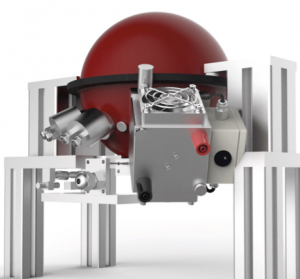
Reference Light Source for Sensitivity Adjustment of Combined Rain and Ambient Light Sensors
Integrating sphere light sources are widely used in the characterization and calibration of imaging sensors and cameras. In this application, the integrating sphere light source serves as a reference light source that can uniformly illuminate all of the many individual light-sensitive detectors (pixels). This enables the relative sensitivity of the pixels to be adjusted as required.
Integrating sphere light sources emit a constant radiance in all directions of a hemisphere (i.e. Lambertian distribution) [1] and are therefore most suitable for adjusting the optoelectronic sensors found in a wide variety of applications. One such application is the adjustment of combined rain and ambient light sensors used in the automotive industry.
Combined Rain and Ambient Light Sensors
For improved comfort and safety, optoelectronic sensors are used as combined rain and ambient light sensors in vehicles. These automatically switch on windshield wipers when rain starts as well as control the wiper speed based on the amount of rain. In addition, they switch on the driving lights when twilight sets in or when entering a tunnel.
The rain sensor is based on the principle of total internal reflection and constructed from an NIR source set at an angle to the windscreen and an NIR detector, forming a detection area within a section of the windshield. Raindrops falling on this sensor section reduce the level of NIR radiation reflected back to the detector enabling the control of the windscreen wipers.
The ambient light sensor measures the brightness in front of the vehicle and automatically switches the driving lights on and off when a limit values are reached. An additional sensor can support more accurate tunnel detection. Ambient light sensors are sensitive in the visible spectral range so that they closely match the sensitivity function of the human eye.

Measurement Systems for the Calibration and Adjustments of Rain and Ambient Light Sensors
The tolerances of the detectors used within the sensors and their measuring geometry set-ups require individual adjustments. An integrating sphere light source with an external halogen lamp provides a suitable reference light source for these adjustments. Since the sensor unit is positioned directly at the sphere output for adjustment, the sphere surface provides uniform illumination of all the individual detectors with diffuse radiation characteristics over their particular field of view. This results from the homogeneous light distribution of the integrating sphere. A monitor detector with photometric sensitivity fitted to the integrating sphere provides a luminance level reference for the adjustment of the light level sensor. Similarly, the radiance level reference for the adjustment of the rain sensor is provided by an NIR sensitive monitor detector. The halogen lamp is located outside the sphere enabling the radiance of the uniform source to be adjusted as required by a variable aperture. The integrating sphere light source is calibrated in luminance and radiance. The modular sphere concept from Gigahertz-Optik GmbH can be configured to provide a suitable reference source for many types and sizes of optoelectronic sensors.